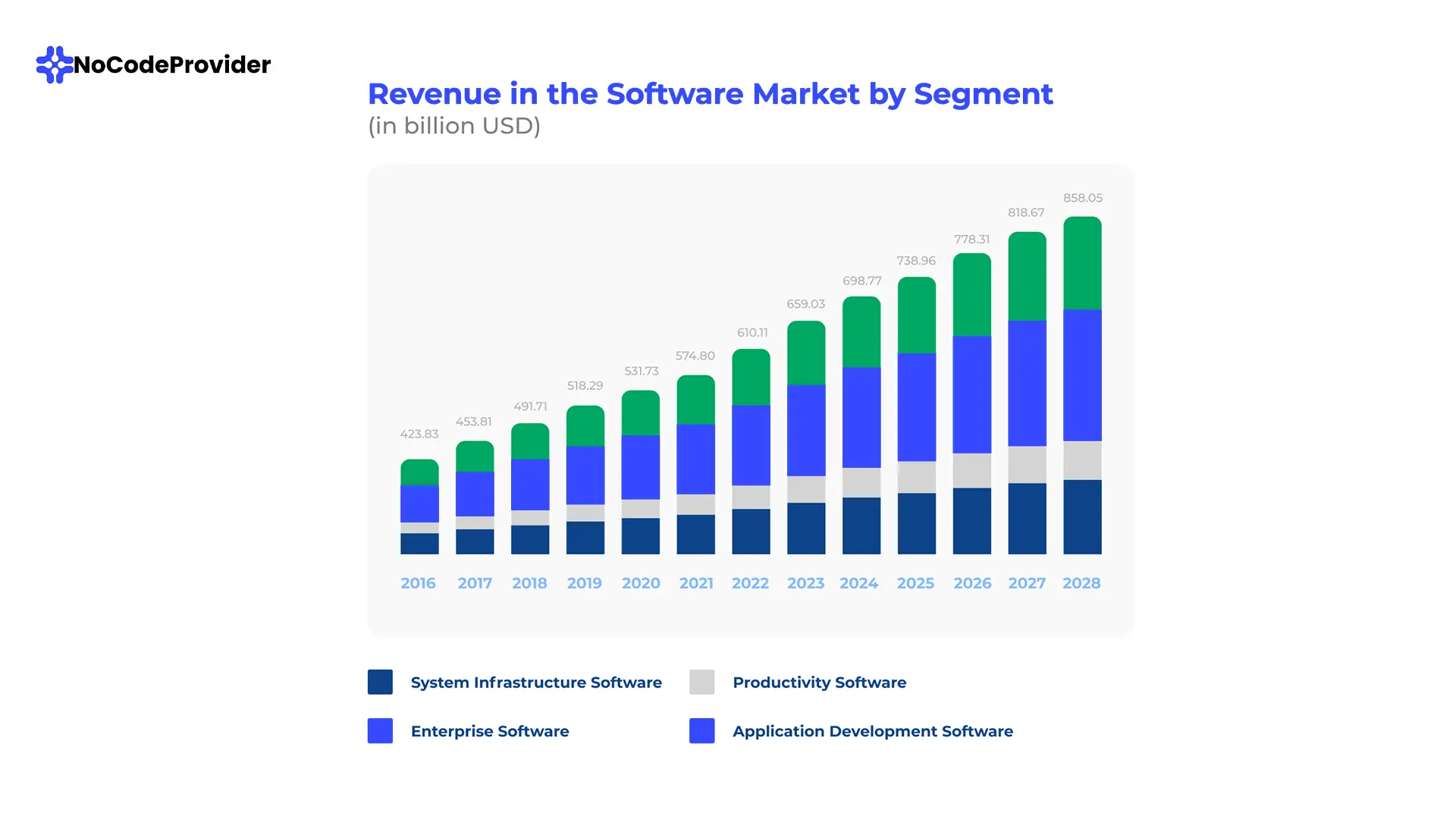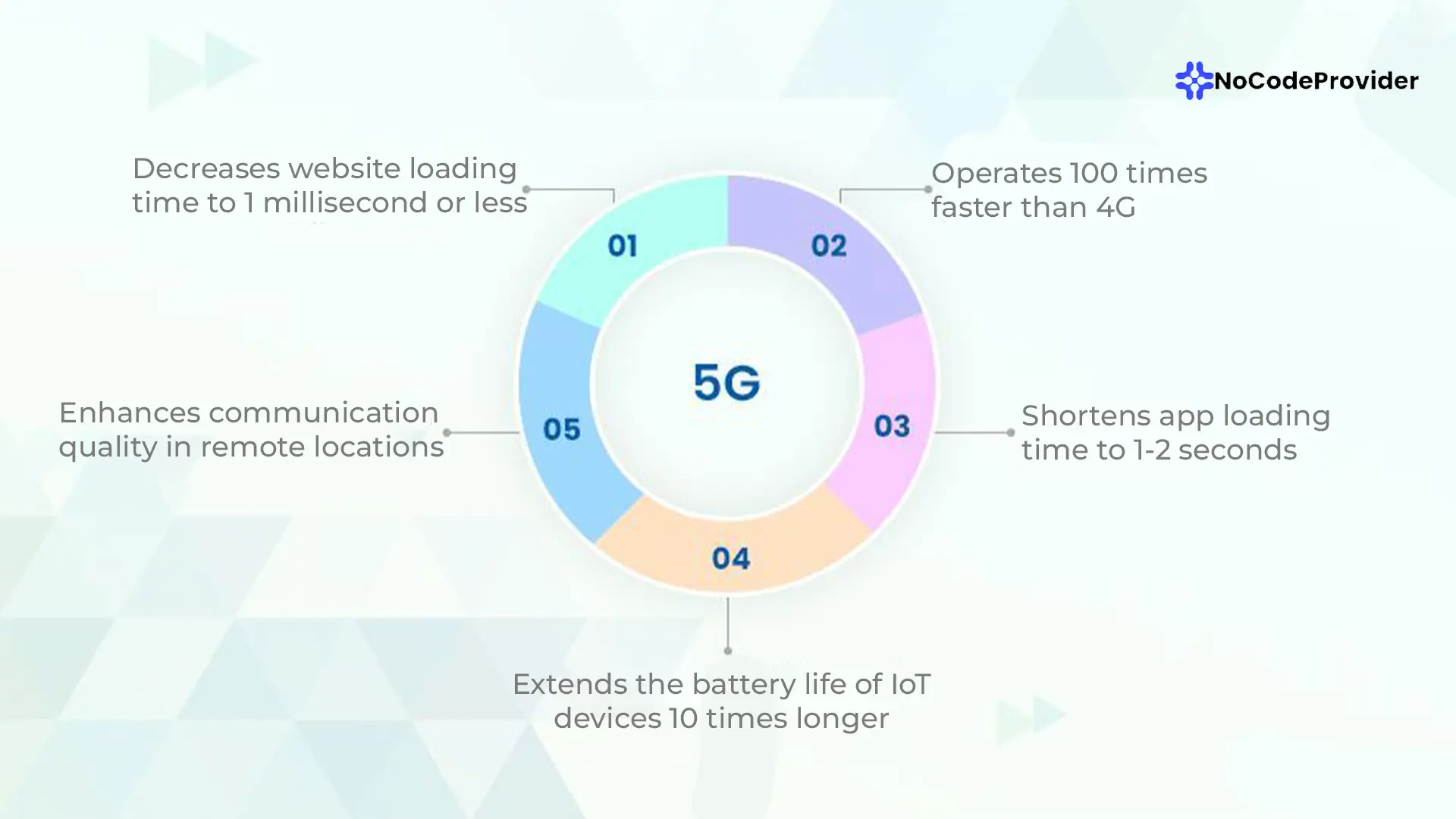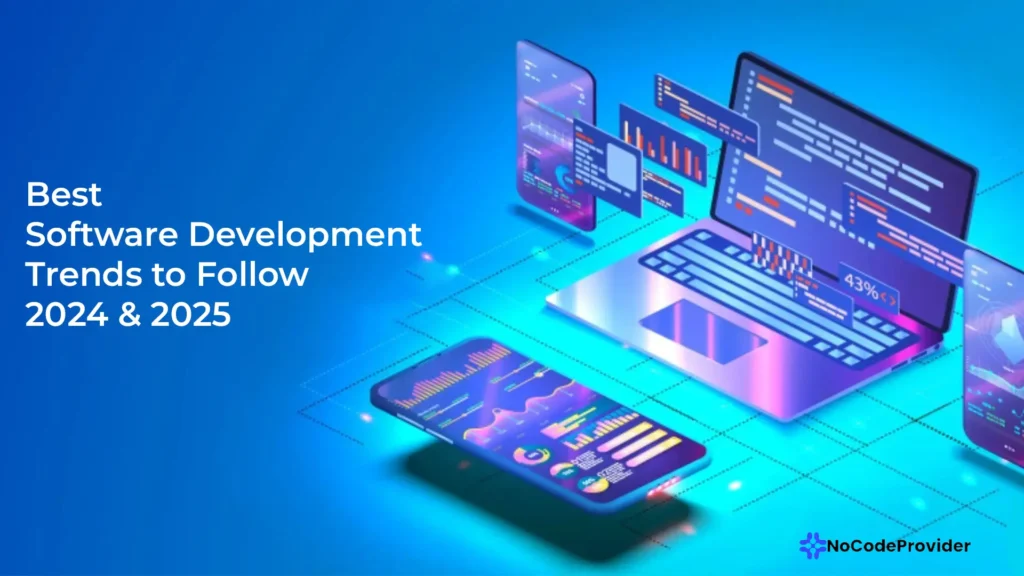Software development is the process of conceptualizing, designing, creating, testing, and maintaining software applications and systems. It begins with gathering requirements, where developers work to understand users’ and stakeholders’ needs and expectations to define the software’s intended functionalities. This phase is followed by planning, which establishes the project scope, timeline, resources, and methodologies.
In 2025, businesses will face increased financial challenges due to record-high inflation. Leaders must navigate tighter budgets to achieve higher returns on investment, all with fewer resources.
However, there’s some good news. Despite the economic challenges, businesses remain focused on investing in technological upgrades. Studies show that about 70% of companies still see growth as a key priority, and those who promote new technologies early tend to experience faster and more substantial progress.
This article will explore the top software development trends in 2024 and 2025. Staying ahead of these trends enables developers and businesses to stay ahead of the curve and consistently offer innovative, up-to-date solutions.
At NoCodeProvider, we deliver a full suite of services, including consulting, engineering, and support. As a trusted software solutions provider, we specialize in custom low-code/no-code development and consultation, IoT solutions, mobile app development, and more designed to meet your specific requirements.
Connect with us today to consult with one of our experts!
Market Stats About Software Development
- According to Gartner, 91% of organizations have initiated digital transformation efforts, with 87% of senior business executives identifying digitalization as a key focus area.
- Moreover, 89% of companies are transitioning to a digital-first business model for the future.
- Statista estimates that the software development market is expected to generate revenues of approximately $738.96 billion by 2025.
- Enterprise software is anticipated to lead the market, reaching a projected volume of $312.80 billion, followed by application development software at $193.30 billion, system infrastructure software at $151.20 billion, and productivity software at $81.66 billion.

Key Software Development Trends for 2024 and 2025
In 2024, some of the most notable trends in software development include advancements in artificial intelligence (AI), machine learning, and cloud computing. DevSecOps (Development, Security, and Operations) and microservices architecture also shape how software is built and maintained.
Many of these trends have evolved from the ongoing changes within the IT sector. The move towards more digital solutions has significantly influenced how software is created, deployed, and managed today.
Agile development methodologies have also become more widespread, enabling shorter development cycles, even in remote or hybrid work environments. Just ten years ago, much of this progress was only possible to imagine with the enhanced collaboration tools that modern technology now offers.
These trends reflect a larger effort to optimize existing workflows, improve digital integration, and adopt emerging technologies in software development.
Let’s dive into some of the key technologies driving these trends in the software industry.
1. Growing Integration of AI and Machine Learning
A major trend shaping software development is the increased adoption of artificial intelligence (AI) and machine learning (ML) across industries. Software development companies use these technologies globally to enhance data-driven decision-making and develop predictive analytics solutions.
AI tools like GitHub Copilot can significantly boost developers’ productivity, enabling them to work more efficiently. The following statistics indicate that searches for GitHub Copilot have increased by 8,000% over the past five years.

From small startups to tech giants, the use of AI and ML has surged, with businesses of all sizes incorporating these technologies. This growth is expected to continue, with AI predicted to surpass half a trillion dollars this year. The AI Market is expected to reach $1.87 trillion by 2030, with a compound annual growth rate (CAGR) of 38.1% projected from 2022 to 2030.
Key trends in AI development include:
- Automated Machine Learning (AutoML): Streamlines complex data analysis, making advanced machine learning accessible and efficient across various industries.
- Generative AI: Enabling businesses to create original content like videos, images, and sounds using AI-generated data.
- Natural Language Processing (NLP): Enhancing communication between users and algorithms through advanced language understanding.
- Ethical AI: Focusing on trust and security, ensuring AI systems are reliable and secure.
Interesting Read: Leverage the Power of Top 25 AI Marketing Tools to Improve Your Business Productivity
2. Growing Investment in Progressive Web Apps (PWAs)
Progressive Web Apps (PWAs), introduced in 2015, are now experiencing wider adoption. The Progressive Web App (PWA) market is forecasted to grow at a compound annual growth rate (CAGR) of 31.9%, with an expected value of $10.44 billion by 2027.
As mobile usage continues to rise, PWAs offer businesses a way to enhance their websites by providing a more app-like user experience. This technology improves site functionality and aesthetics, making it appealing to many companies.
In recent years, more businesses have begun converting their sites into PWAs. Pinterest, for example, made headlines when it revamped its platform into a PWA in 2017 after identifying performance and retention issues. The conversion, which involved rebuilding the site with React, led to a 40% increase in user engagement and a 44% boost in revenue.
3. Expanding Application of Blockchain Technology Beyond FinTech
Blockchain is no longer just a fintech innovation; in 2024, it will have a broader impact on software development across various industries. Businesses are increasingly recognizing the potential of blockchain, mainly due to its decentralized nature, which provides enhanced security and transparency.
Industries such as media, healthcare, publishing, and supply chain management are beginning to implement blockchain technology because of its resistance to hacking and corruption. As developers continue to create custom software solutions that use blockchain, the market for this technology is set to grow at a CAGR of 58.90%, reaching a value of $20 billion by the end of 2024.
Blockchain’s unique ability to ensure security and trust is integral to future software development strategies across multiple sectors.
4. Growing Emphasis on Cybersecurity with DevSecOps
DevSecOps combines development, security, and operations into one approach. It focuses on automating processes, designing secure platforms, and promoting a security-first culture throughout the development lifecycle. It integrates security throughout the entire IT process, making it a shared responsibility from start to finish.
More companies are strengthening their cybersecurity frameworks with DevSecOps because it embeds security directly into the development process rather than adding security measures around existing systems. The focus is detecting and addressing potential risks early, preventing small issues from becoming bigger threats.
DevSecOps also promotes better collaboration between teams by breaking down traditional silos and ensuring security is a key consideration in every commit and pull request. Compliance remains a top priority, with regular security and compliance checks built into the development pipeline.
5. Increased Adoption of Low-Code/No-Code Development
Developing software can often be a lengthy and resource-intensive process. Low-code and no-code development solutions have emerged as a quicker, more efficient way for developers to create apps with minimal coding, allowing projects to be completed much faster.
Gartner predicts that by 2026, more than 50% of companies will adopt low-code platforms. Multiple factors are contributing to this shift, such as:
- The rise of business technologists
- Increasing levels of automation in enterprises
- A shift towards composable business models
Varsha Mehta, a Senior Market Research Specialist at Gartner, notes that organizations are turning to low-code technologies to meet the demand for rapid app delivery and customized automation workflows.
These platforms allow businesses to develop apps on tighter budgets and within shorter timeframes. Popular low-code platforms consist of Mendix, Appian, and Visual LANSA.
Common use cases for low-code development include:
- Adding custom features to existing SaaS platforms
- Migrating from traditional spreadsheets to cloud-based relational databases
- Modernizing legacy applications for improved functionality
6. NFT Tokens in Cryptocurrency
Non-fungible tokens (NFTs) are unique digital assets linked to the blockchain. They are termed “non-fungible” because each token is one-of-a-kind and cannot be exchanged for another on a one-to-one basis.
The distinctiveness of NFTs has contributed to their rise as a prominent trend, particularly in blockchain-based payments. This payment method has gained popularity in software development outsourcing because it facilitates quick, secure, and transparent transactions between parties.
The NFT market is anticipated to experience substantial growth, potentially reaching a value of $211.7 billion by 2030, with an impressive growth rate of 34.2%. These tokens operate on smart contracts, self-executing pieces of code that enable swift and secure transactions.
7. Growing Demand for Python Developers
Machine learning and data science fields are driving a surge in the need for skilled Python developers. Often referred to as the “Swiss Army knife” of programming languages, Python is versatile enough to handle various tasks and complex projects.
Its adaptability keeps it relevant across various domains, from web design and application development to building machine learning models. Python’s usage is expected to rise in several key areas, including game development, artificial intelligence, machine learning applications, Internet of Things (IoT) projects, web and mobile applications, and automation and robotics.
8. 2024 – The Year of 5G Technology
As we enter a new technological phase marked by the swift expansion of 5G, projections indicate that by 2025, over 1.4 billion devices will be connected to this network—representing nearly 15% of the total worldwide.
What’s driving this trend?
5G is a monumental leap beyond its predecessor, 4G. It’s not merely an enhancement but a completely reimagined network framework that has the potential to transform our communication and engagement with the digital environment.
This advancement promises to improve user experiences and stimulate the development of advanced software technologies such as the Internet of Things (IoT), Augmented Reality (AR), and Artificial Intelligence (AI).

The outlook for 5G is undoubtedly promising, and now is the perfect opportunity to position yourself for success in this digital world.
So, what are you waiting for? Begin optimizing your current applications for the rapid speeds of 5G, or create new ones that handle the features of this revolutionary technology in software development!
9. The Ongoing Evolution of Web 3.0
Web 3.0 is often regarded as the future of the Internet, driven by innovative technologies and advancements in software development. Its architecture is structured around three fundamental tiers:
- Interaction: This involves the content, hardware, and software users use.
- Computation: This tier encompasses the logic to enable user interactions with the components above.
- Information: This refers to the data and organizational framework essential for performing computational tasks accurately and efficiently.
Web 3.0 applications stand out due to their intricate design and interactive features. They move beyond the static pages typical of earlier web versions. They use JavaScript development to create dynamic and responsive user experiences.
10. Edge Computing
Edge computing derives its name from processing data closer to the “edge” of the network, or where the data is generated, to minimize latency and bandwidth consumption. Research indicates that the global edge computing market will grow at % compound annual growth rate (CAGR) of 37.4% by 2027. Fortune Business Insights projects that this market will grow from $15.96 billion in 2023 to $139.58 billion by 2030.
This computing model is especially vital for IoT devices, which produce vast amounts of data. It enhances privacy and security by keeping data local instead of relying on centralized cloud platforms, often farther from data sources.
Edge computing represents an advancement of on-premise computing. It functions as an IT architecture that processes client data at the network’s edge, near where it is generated. By bringing computing capabilities closer to data sources, edge computing effectively reduces latency and enhances real-time data processing.
This technology is particularly beneficial for applications requiring immediate data analysis, such as autonomous vehicles and smart city initiatives. In healthcare, edge computing ensures maximum data privacy and facilitates AI-driven real-time monitoring and detailed analysis of patients’ conditions.
When implemented, edge computing can transform traffic management by optimizing traffic lanes, adjusting bus schedules, and managing the flow of autonomous vehicles.
Final Note!
Current software development trends reflect the rapid shift to digital solutions and the integration of AI with emerging technologies that enhance our work and lives.
While dependable programming languages like Python and JavaScript remain essential in software development, innovative approaches such as serverless computing, edge computing, DevSecOps, FinOps, and GreenOps are emerging to meet the changing needs of modern workplaces.
Check out our extensive no-code tools directory to find solutions that simplify your development needs. Whether you want to build apps or automate tasks, we have the right tools!

